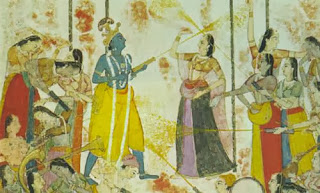
छैल जो छबीला, सब रंग में रंगीला
बड़ा चित्त का अड़ीला, कहूं देवतों से न्यारा है।
माल गले सोहै, नाक-मोती सेत जो है कान,
कुण्डल मन मोहै, लाल मुकुट सिर धारा है।
दुष्टजन मारे, सब संत जो उबारे ताज,
चित्त में निहारे प्रन, प्रीति करन वारा है।
नन्दजू का प्यारा, जिन कंस को पछारा,
वह वृन्दावन वारा, कृष्ण साहेब हमारा है।।
सुनो दिल जानी, मेरे दिल की कहानी तुम,
दस्त ही बिकानी, बदनामी भी सहूंगी मैं।
देवपूजा ठानी मैं, नमाज हूं भुलानी,
तजे कलमा-कुरान साड़े गुननि गहूंगी मैं।।
नन्द के कुमार, कुरबान तेरी सुरत पै,
हूं तो मुगलानी, हिंदुआनी बन रहूंगी मैं।।
(ताज़बीबी का एक प्रसिद्ध पद)
Some towns, especially old towns, carry about them a distinct aura. One may have never lived in them, and yet their mere mention brings swiftly to mind a host of images, associations, slivers of history. Consider Sirhind, the small town that lies in the plains of the Punjab, on the great medieval highway that connected Delhi to Lahore.
Not many might give thought to the origins of its name—it comes probably, as seen through Muslim invaders’ eyes, from ‘sar-i hind’, meaning, roughly, the very ‘gateway to Hindustan’—but most Punjabis know it as the place where the two younger sons of Guru Gobind Singh were martyred.
Little wonder then that a 19th century French traveller, who passed through Sirhind, described the town as "the biggest ruin I have ever seen in India after Delhi`85 ruins which cover the ground for a space of more than 15 square kilometers".
Time was when the town boasted of as many as 360 monuments, they say: mosques, cenotaphs, gardens, caravanserais, wells, and gardens. Very few of them have survived, but whatever have—apparently 37 in number—are documented here.
The names of these are a study in themselves: the tombs of Taj Bibi, Sheikh Ahmed Sirhindi, Haji Muhammad, Subhan, Khwaja Muhammad Naqshband, Ustad and Shagird, Muhammad Isma’il, Shah Zaman, for instance; mosques like Sadna Qasai, Lal Masjid, inside the Rauza Sharif; gardens like Jahazi Mahal, Aam Khas; and so on.
Cities rise and decline. But everything, including ruins, needs to be documented and preserved. The town of Sirhind may no longer be the "envy of China", nor its environs be "like the locks of the cheek of graces", or its dust like "collyrium for the eyes of soul", as an old Persian poets put it. But it remains a place deserving of careful, close study. And it is precisely this that Subhash Parihar has done in his densely researched recent work on the History and Architectural Remains of Sirhind.
And so many of those that have not crumbled to the ground have trees and vines and weeds growing though their cracks. "Ug rahaa hai dar-o deewaar pe sabzaa, Ghalib", as the poet said.
http://www.tribuneindia.com/2007/20070415/spectrum/art.htm
 अकबर के नवरत्नों में एक अब्दुर्ररहीम खानखाना अपने जीवन की संझाबेला में वे चित्रकूट आ गए और भगवान राम की भक्ति करने लगे।
अकबर के नवरत्नों में एक अब्दुर्ररहीम खानखाना अपने जीवन की संझाबेला में वे चित्रकूट आ गए और भगवान राम की भक्ति करने लगे।


















































